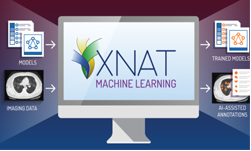 Building on the announcement at RSNA 2019, XNAT, the most widely-used open-source informatics platform for imaging research, announced the beta release of XNAT Machine Learning (XNAT ML).
Building on the announcement at RSNA 2019, XNAT, the most widely-used open-source informatics platform for imaging research, announced the beta release of XNAT Machine Learning (XNAT ML).
XNAT, one of the most widely-used open-source informatics platforms for imaging research, announced the general release of XNAT 1.8 on March 10. Building on the announcement of XNAT ML Beta in the summer of 2020, XNAT will accelerate the creation of AI models by providing an end-to-end development platform, enabling faster collaborations between data science and clinical teams.
XNAT, in collaboration with NVIDIA, Radiologics, and the ICR Imaging Informatics group, announced the general availability of XNAT 1.8, adding support for model training and AI-assisted annotation workflows. This integration was first announced at the RSNA 2019 conference, where a proof of concept was demonstrated using models and APIs from the NVIDIA Clara Imaging framework with accelerated GPU computing.
The XNAT release introduces new capabilities with the XNAT imaging research platform, accelerated by GPUs:
- Assemble training-specific collections of imaging data files into specific training projects to build balanced data cohorts
- Draw new segmentations and annotations on that data, using NVIDIA Clara Train’s AI-assisted annotation
- Install and configure pre-trained models from Clara Train, available through NVIDIA NGC into the XNAT ML environment
- Train models with annotated datasets using training framework provided by NVIDIA Clara Train
NVIDIA Clara Imaging is an application framework that accelerates the development and deployment of AI in medical imaging. Built for anyone building AI models, Clara Imaging offers pre-trained models, collaborative techniques to train robust AI models without sharing patient data across institutions, and end-to-end software for scalable and modular AI deployments.
